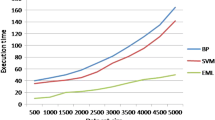Abstract
In Chinese, dependency analysis has been shown to be a powerful syntactic parser because the order of phrases in a sentence is relatively free compared with English. Conventional dependency parsers require a number of sophisticated rules that have to be handcrafted by linguists, and are too cumbersome to maintain. To solve the problem, a parser using SVM (Support Vector Machine) is introduced. First, a new strategy of dependency analysis is proposed. Then some chosen feature types are used for learning and for creating the modification matrix using SVM. Finally, the dependency of phrases in the sentence is generated. Experiments conducted to analyze how each type of feature affects parsing accuracy, showed that the model can increase accuracy of the dependency parser by 9.2%.
Similar content being viewed by others
References
Cortes, C., Vapnik, V.M., 1995. Support Vector Networks. Machine Learning, 20:273–297.
Charniak, E., 1993. Statistical Language Learning. The MIT Press, Cambridge, p. 116–121.
Collins, M., 1996. A New Statistical Parser Based on Bigram Lexical Dependencies. Proceedings 34th Annual Meeting of Association for Computational Linguistics. University of California, Santa Cruz, CA, p.184–191.
Guo, Y.H., Zhou, C.L., 2000. A study of the parsing strategy and the generative algorithm for dependency relation network of Chinese sentences. Journal of Zhejiang University (Engineering Science), 27:637–645 (in Chinese).
Hirao, T., Isozaki, H., 2002. Extracting Important Sentences with Support Vector Machines. Proceedings of the 19th International Conference on Computational Linguistics. Taipei University, Taipei, p.342–348.
Kudo, T., Matsumoto, Y., 2001. Chunking with Support Vector Machines. Proceedings of NAACL 2001. Carnegie Mellon University, Pittsburgh, PA, USA, p.192–199.
Li, J.M., Zhang, B., Lin, F.Z., 2003. Training algorithms for Support Vector Machines. Journal of Tsinghua Univ. (Sci. & Tech.), 43:32–37 (in Chinese).
Magerman, D., 1995. Statistical Decision Tree Model for Parsing. Proceedings 33rd Annual Meeting of Association for Computational Linguistics. Massachusetts, Cambridge, p.276–283.
Zhang, Y.Q., Zhou, Q., 2002. Automatic identification of Chinese Base Phrase. Journal of Chinese Information Processing, 16:1–8 (in Chinese).
Author information
Authors and Affiliations
Rights and permissions
About this article
Cite this article
Xu, Y., Zhang, F. Using SVM to construct a Chinese dependency parser. J. Zhejiang Univ. - Sci. A 7, 199–203 (2006). https://doi.org/10.1631/jzus.2006.A0199
Received:
Accepted:
Published:
Issue Date:
DOI: https://doi.org/10.1631/jzus.2006.A0199




